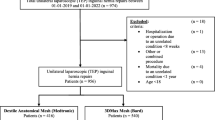Abstract
Background
The shrinkage of mesh has been cited as a possible explanation for hernia recurrence. Expanded polytetrafluoroethylene (ePTFE) is unique in that it can be visualized on computed tomography (CT). Some animal studies have shown a greater than 40% rate of contraction of ePTFE; however, very few human studies have been performed.
Study design
A total of 815 laparoscopic incisional/ventral hernia (LIVH) repairs were performed by a single surgical group. DualMesh Plus (ePTFE) (WL Gore & Associates, Newark, DE) was placed in the majority of these patients using both transfascial sutures and tack fixation. Fifty-eight patients had postoperative CTs of the abdomen and pelvis with ePTFE and known transverse diameter of the implanted mesh. The prosthesis was measured on the CT using the AquariusNet software program (TeraRecon, San Mateo, CA), which outlines the mesh and calculates the total length. Data were collected regarding the original mesh size, known linear dimension of mesh, seroma formation, and time interval since mesh implantation in months.
Results
The mean shrinkage rate was 6.7%. The duration of implantation ranged from 6 weeks to 78 months, with a median of 15 months. Seroma was seen in 8.6% (5) of patients. No relationship was identified between the percentage of shrinkage and the original mesh size (P = 0.78), duration of time implanted (P = 0.57), or seroma formation (P = 0.074). In 27.5% (16) of patients, no shrinkage of mesh was identified. Of the patients who did experience mesh shrinkage, the range of shrinkage was 2.6–25%.
Conclusions
Our results are markedly different from animal studies and show that ePTFE has minimal shrinkage after LIVH repair. The use of transfascial sutures in addition to tack fixation may have an implication on the mesh contraction rates.



Similar content being viewed by others
References
** J, Rosen MJ (2008) Laparoscopic versus open ventral hernia repair. Surg Clin North Am 88:1083–1100
Jonas J (2009) The problem of mesh shrinkage in laparoscopic incisional hernia repair. Zentralbl Chir 134(3):209–213
LeBlanc KA, Booth WV (1993) Laparoscopic repair of incisional abdominal hernias using expanded polytetrafluoroethylene: preliminary findings. Surg Laparosc Endosc 3(1):39–41
Burger JWA, Halm JA, Wijsmuller AR et al (2006) Evaluation of new prosthetic meshes for ventral hernia repair. Surg Endosc 20:1320–1325
Schoenmaeckers EJ, van der Valk SB, van den Hout HW et al (2009) Computed tomographic measurements of mesh shrinkage after laparoscopic ventral incisional hernia repair with an expanded polytetrafluoroethylene mesh. Surg Endosc 23:1620–1623
Schug-Pass C, Tamme C, Tannapfel A et al (2006) A lightweight polypropylene mesh (TiMesh) for laparoscopic intraperitoneal repair of abdominal wall hernias: comparison of biocompatibility with the DualMesh in an experimental study using the porcine model. Surg Endosc 20:402–409
LeBlanc KA (2004) Current considerations in laparoscopic incisional and ventral herniorrhaphy. JSLS 4:131–139
LeBlanc KA (2002) A new method to insert the dualmesh prosthesis for laparoscopic ventral herniorrhaphy. JSLS 6:349–352
Novitsky YW, Cristiano JA, Harrell AG et al (2008) Immunohistochemical analysis of host reaction to heavyweight-, reduced-weight-, and expanded polytetrafluoroethylene (ePTFE)-based meshes after short- and long-term intraabdominal implantations. Surg Endosc 22:1070–1076
Demir U, Mihmanli M, Coskun H et al (2005) Comparison of prosthetic materials in incisional hernia repair. Surg Today 35:223–227
Brown CN, Finch JG (2010) Which mesh for hernia repair? Ann R Coll Surg Engl 92:272–278
Schreinemacher M, Henatsch D, van Barneveld K et al (2010) The need for standardised animal models and scoring systems in assessing mesh biocompatibility. Hernia 14:335–336
Langer C, Forster H, Konietschke F et al (2010) Mesh shrinkage in hernia surgery: data from a prospective randomized double-blinded clinical study. Chirurg 81:735–742, 744–5
Rkein AM, Harrigal C, Friedman AC et al (2009) Comparison of the accuracy of CT volume calculated by circumscription to prolate ellipsoid volume (bidimensional measurement multiplied by coronal long axis). Acad Radiol 16:181–186
LeBlanc KA (2007) Laparoscopic incisional hernia repair: are transfascial sutures necessary? A review of the literature. Surg Endosc 21:508–513
Brill JB, Turner PL (2011) Long-term outcomes with transfascial sutures versus tacks in laparoscopic ventral hernia repair: a review. Am Surg 77:458–465
Beldi G, Wagner M, Bruegger LE et al (2011) Mesh shrinkage and pain in laparoscopic ventral hernia repair: a randomized clinical trial comparing suture versus tack mesh fixation. Surg Endosc 25:749–755
Bansal VK, Misra MC, Kumar S et al (2011) A prospective randomized study comparing suture mesh fixation versus tacker mesh fixation for laparoscopic repair of incisional and ventral hernias. Surg Endosc 25:1431–1438
LeBlanc KA, Whitaker JM, Bellanger DE et al (2003) Laparoscopic incisional and ventral hernioplasty: lessons learned from 200 patients. Hernia 7:118–124
Acknowledgments
The authors would like to thank Tom Sabin for his assistance with the statistical analysis.
Author information
Authors and Affiliations
Corresponding author
Rights and permissions
About this article
Cite this article
Carter, P.R., LeBlanc, K.A., Hausmann, M.G. et al. Does expanded polytetrafluoroethylene mesh really shrink after laparoscopic ventral hernia repair?. Hernia 16, 321–325 (2012). https://doi.org/10.1007/s10029-011-0898-6
Received:
Accepted:
Published:
Issue Date:
DOI: https://doi.org/10.1007/s10029-011-0898-6




